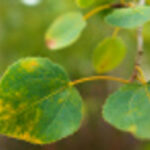When people think of the Sonoran Desert, hillsides studded with Saguaro cactus and cholla often come to mind. But interspersed between the cactus, you will find the beautiful Palo Verde trees. Their unique green trunks are perhaps their most notable feature. The word “Palo Verde” means “green stick” in Spanish, referring to their green trunk, which is actually a survival mechanism in response to drought. Palo Verde trees are “drought deciduous”, which means that they will drop their leaves in response to a drought situation. Their green trunks and branches are able to carry on photosynthesis, even in the absence of leaves.
There are two species of Palo Verde are native to the Desert Southwest; Blue Palo Verde (Parkinsonia florida), formerly (Cercidium floridum) and Foothill Palo Verde (Parkinsonia microphylla), formerly (Cercidium microphyllum). Two other species of Palo Verde that are prevalent in the landscape are the Palo Brea (Parkinsonia praecox), formerly (Cercidium praecox) and a hybrid known as (Parkinsonia x ‘Desert Museum’).
In the desert, Palo Verde trees act as a “nurse plant” to young Saguaro cacti by protecting them from the cold in the winter and from the intense sun in the summer. In the spring, they burst out in a beautiful cloud of yellow flowers. Small, light brown seed pods are produced once flowering has finished. Thorns are present along the branches of Palo Verde trees, except for the ‘Desert Museum’, which is thornless. The cold hardiness range of these trees is around 15 to 20 degrees F.
USES: Palo Verdes serve as wonderful specimen trees where their green trunks, branch structure and flowers are a wonderful focal point. They are drought tolerant, once established. They provide nice filtered shade year-round. When deciding where to place, be sure to take into account that they need a lot of room to grow, mature sizes are listed below. Palo Verdes do not do well when planted in grass. Locate away from swimming pools due to flower litter in the spring. *Because of their larger thorns and branching tendency to point downwards, Palo Breas are not recommended in areas close to foot traffic.
Mature Sizes:Blue Palo Verde – 30 ft x 30 ft’Desert Museum’ Palo Verde – 30 ft high x 40 ft widePalo Brea – 30 ft x 25 ftFoothills Palo Verde – 20 ft x 20 ft
MAINTENANCE: Prune to elevate the canopy and maintain good structure. Avoid hedging and “topping” trees as this stimulates excess, weak growth.
In addition to the Saguaro cactus, Palo Verde trees are an iconic part of the Sonoran Desert Landscape. The stark beauty of their green branches reaching into the blue desert sky is visually compelling. With four different species to choose from, there is one that is right for your desert landscape.



